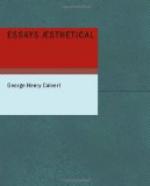volumes of tales put together. What insight,
what weight, and faithfulness, and refinement, and
breadth, and truth, and elevation of character and
conception, does the framework of incident support
and display? That is the aesthetic question.
The novels of every day bristle with this material
inventiveness, this small, abounding, tangled underwood
of event and sensation, which yields no timber and
wherein birds will not build. The invention exhibited
in the punishments and tortures and conditions of
the “Inferno” and “Purgatorio”
and “Paradiso,” is not admirable for their
mere exuberance and diversity,—for that
might have come from a comparatively prosaic mind,
especially when fed, as all minds then were, with
the passionate mediaeval beliefs,—but for
the heart there is in them, throbbing deeply in some,
and for the human sympathy, and thence, in part, the
photographic fidelity, and for the paramount gift
poetically to portray. A consequence of the choice
of subject, and, as regards the epic quality of Dante’s
poem, an important consequence, is that there is in
it no unity of interest. The sympathies of the
reader are not engrossed by one great group of characters,
acting and reacting on one another through the whole
sweep of the invention. Instead of this, we have
a long series of unconnected pictures, each one awakening
a new interest. Hereby the mind is distracted,
the attention being transferred at every hundred lines
to a fresh figure or group. We pass through a
gallery of pictures and portraits, classed, to be
sure, by subjects, but distinct one from the other,
and separated by the projection of as many different
frames. We are on a weird, adventurous journey,
and make but brief stops, however attractive the strangers
or acquaintance we meet. We go from person to
person, from scene to scene; so that at the end of
the journey, although the perception has been richly
crowded, one impression has effaced the other.
Not carrying the weight, not pulsating in its every
limb with the power of a broad, deep, involved story,
architecturally reared on one foundation, whose parts
are all subordinated to a great unity, the “Divina
Commedia,” as an organic, artistic whole, is
inferior to the “Iliad” and “Paradise
Lost,” and to the Grecian and Shakespearean
tragedies.
The exclusive super-earthliness of his scenes and
personages, and, with this, his delight in picture-drawing,
keep Dante close to his page—fastened to
it, we might say, by a twofold fascination. Among
the many faculties that equip him for his extraordinary
task, most active is that of form. Goethe says
of him, “The great intellectual and moral qualities
of Dante being universally acknowledged, we shall
be furthered in a right estimate of his works, if we
keep in view that just in his life-time—Giotto
being his contemporary—was the re-birth
of plastic art in all its natural strength. By
this sensuous, form-loving spirit of the age, working
so widely and deeply, Dante, too, was largely swayed.




